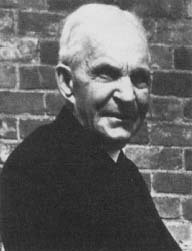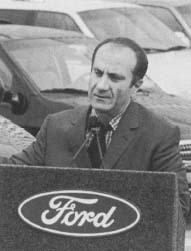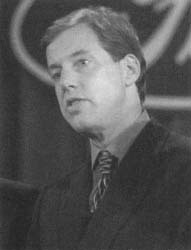Henry Ford
Born: July 30, 1863
Springwells, Michigan
Died: April 7, 1947
Dearborn, Michigan
Founder, Ford Motor Company

Henry Ford not only founded the Ford Motor Company, he helped give birth to the automobile industry in the United States. With his innovations to the manufacturing process and his commitment to his workers, he became a true American legend of the twentieth century. Although Ford died in 1947, his name continues to be stamped on every car and truck that rolls off a Ford assembly line today.
He Liked to Tinker
Henry Ford was born on a farm in 1863 in Springwells, Michigan (now a part of Dearborn, Michigan). He was the second child of William and Mary Ford, whose first son died as a baby. When Henry was twelve his mother died from complications of childbirth and the Ford household changed forever. To manage his grief and the hard life of farming, Ford took to tinkering. He could fix many things around the homestead, but he especially had a keen interest in the workings of watches.
"Even a mistake may turn out to be the one thing necessary to a worthwhile achievement."
Ford worked as an apprentice at a machinery shop in Detroit in 1879; he fixed watches after hours. The following year, he went to work at the shipyards and helped repair large dock machinery. He also continued to help out at the family farm. In 1885, he met Clara Bryant. The two married in April 1888, and lived in a log cabin built by Ford using a small, motorized sawmill. In his spare time Ford cut and sold lumber and continued to dabble with a variety of motors, both gasoline-powered and steam-driven.
Jacques Nasser: Taking Care of Business
Jacques Nasser was a pivotal part of the Ford Motor Company for over thirty years, working his way up from a trainee in 1968 to his resignation as chief executive officer (CEO) and president in 2001. A shrewd businessman, he was transferred to Ford divisions around the globe where he turned sluggish operations profitable. His "can-do" attitude landed him the top slot at Ford in 1999, where he reigned until a series of unfortunate events, including the failure of Firestone tires on Ford Explorers, led to his departure.

Jacques Albert Nasser was born in Amyoun, Lebanon, in 1947. He moved with his parents to Melbourne, Australia, at age four. Nasser was brought up speaking both Arabic and French, and during his youth enjoyed sports and starting home-based businesses to earn money. After high school he was accepted at the Royal Melbourne Institute of Technology where he made a decision crucial to his future: he applied to a business training program with the Ford Motor's Australian division in 1968.
After graduating, Nasser continued his employment with Ford. He worked his way up the corporate ladder in the 1970s and 1980s, relocating to Ford offices around the world, including South Africa, America, Argentina, Great Britain, and back to Australia. Wherever Nasser went, improvement followed. His willingness to make harsh or unpopular decisions led him to Ford's American headquarters as vice president for product development in 1994, vice president for overall operations in 1996, president of the automotive division in 1997, and CEO and president in 1999.
Nasser's leadership of Ford, however, did not last. Shortly after he took the top spot, it became known that the Firestone tires on Ford's most popular vehicle, the Explorer, were not just faulty but deadly. Amid terrible accidents and resulting lawsuits, Ford Motor went into a tailspin. In an effort to stop the losses and rejuvenate the company, Nasser was replaced by Ford family member William Clay Ford Jr. in late 2001. Although Nasser's reign at Ford ended rather suddenly, his abilities saw the company through many of its darkest periods.
In 1891, Henry and Clara moved to Detroit where Ford worked his way up to chief engineer at the Edison Illuminating Company founded by inventor Thomas Edison (1847-1941), who became a lifelong friend. The couple's only child, son Edsel, was born in 1893. Ford continued to work on motors, especially those designed to propel vehicles. In 1896, he finally developed a working model. Called the "Quadricycle," it was a motorized bicycle with four wheels, which Ford sold for $200. He then went to work on a more advanced model.
Head of an Empire
By the end of the 1890s, automobiles were no longer the stuff of fantasy, but had become the transportation of the future. In 1903, Ford established the Ford Motor Company, joining hundreds of other inventors around the world who were beginning to open their own car manufacturing businesses. As general manager and chief engineer, Ford was responsible for creating the Model A, which had a two-cylinder engine and cost $850. The success of the Model A led to more sophisticated automobiles like the Model B and Model C, and eventually to the company's most famous vehicle, the Model T in 1908. In mid1927 the last Model T came off the assembly line and a revamped Model A took its place. Over four million new Model As were produced over the next four years.
In 1919, although he was still involved with the company bearing his name, Ford retired and son Edsel (1893-1943) took over. Edsel's sons, Henry II (1917-1987), Benson, and William, were also working in the family business. Henry Ford retired to a spacious home on the banks of the Rouge River in Dearborn, Michigan, which was called Fair Lane. Henry and Clara vacationed often in the South, and eventually bought homes in Ft. Myers, Florida, and Richmond Hill, Georgia.
Gasoline in His Veins:
William Clay Ford Jr.
William "Bill" Clay Ford Jr. is the great-grandson of founder Henry Ford. He was named chairman of Ford Motor Company in 1999 and took on the responsibilities of chief executive officer (CEO) in 2001 at age forty-four. His appointment was an important landmark for the company, which had been run by nonfamily members since Henry II, Bill's uncle, resigned in 1979. Although his leadership qualities were untested, Bill Ford has proven an able guide for one of the world' largest companies.

Bill Ford was born in Detroit, Michigan, in 1957, the son of William Clay Sr. and Martha Firestone and the grandson of Edsel, Henry Ford's only child. As a youth, Ford played hockey and soccer, was a good student, and after his father bought the Detroit Lions football team in 1963, became a devoted football fan. He earned a bachelor of arts degree from Princeton University in 1979 and a master's degree from the Massachusetts Institute of Technology (MIT) in 1984.
Ford has often joked about having gasoline in his veins, due to his family's longtime involvement with the design and manufacturing of automobiles. Yet he was never forced into the family business. He chose to join the company in the late 1970s, and worked his way through many departments and divisions until he gained a seat on the board of directors in 1988. In 1998, he was named chairman of the board; he became CEO in 2001.
As an ardent environmentalist, just as his grandfather great-grandfather was, one of Ford's major goals was to make Ford Motor as "Earth-friendly" as possible in the twenty-first century. In addition, he continues his involvement with the Detroit Lions (as vice chairman since 1995) and oversees his great-grandfather's beloved Greenfield Village & Henry Ford Museum in Dearborn, Michigan.
Ford married a fellow Princeton student, Lisa Vanderzee, and they have two daughters and two sons. He says since he was not forced into working in the auto business, he will let his children make their own choices as well regarding their careers. The family lives in Grosse Pointe Farms, an upscale suburb of Detroit, where Ford can be spotted in-line skating through the quiet streets or getting ready for a fly fishing trip. As a nature lover, he likes camping, hiking, and skiing with his family, and also enjoys tae kwon do, hockey, tennis, coaching soccer, and collecting Civil War documents. He has pledged that his job will not detract from his personal life, and has no plans to cut down his involvement with his children. Ford is also a vegetarian who practices alternative healing methods such as acupuncture and herbal remedies, and he does not often drink alcohol.
Retirement did not slow down Henry Ford. He was considered a true American success story, and he was constantly giving interviews to newspapers and magazines. In 1916, he briefly entered politics when he ran for the Senate and lost. Ford was also a best-selling author. His first book, Henry Ford's Own Story: How a Farmer Boy Rose to the Power that Goes with Many Millions, Yet Never Lost Touch with Humanity, was written in 1917 with the help of Rose Wilder Lane, the daughter of famous children's author Laura Ingalls Wilder (1867-1957). Ford went on to publish five more books in the 1920s and 1930s about his life and business beliefs, working with a writer named Samuel Crowther. In 1930, he wrote a memoir about his friend, Thomas Edison, called Edison as I Knew Him.
Leaving It Behind
During his retirement Ford developed a growing interest in collecting artifacts that depicted early American life. This included antique furniture, books, and sometimes buildings. A natural extension of this hobby was building a museum, which he began around the same time he bought and restored an old hotel in Massachusetts called the Wayside Inn. By 1929, Ford's museum had grown into an historic village, which he called the Edison Institute to honor his old friend. The museum and surrounding grounds, located in Dearborn, were opened to visitors in 1933. The complex was eventually named Greenfield Village. It has since become a tourist destination and is overseen by the Ford Foundation, owned by the Ford family.
In the late 1930s, Ford's health was declining, and in 1938 he had a stroke. This was followed by a second, more powerful stroke in 1941. In 1943, more tragedy struck when Edsel died of cancer at the age of forty-nine. Henry and Clara were inconsolable over the loss of their only child. The elder Ford resumed his position as president of Ford Motor Company. The move was temporary, however, as he soon turned leadership over to his oldest grandson, Henry II. Henry II became president in 1945 and Ford, in failing health, retired once again.
For the remainder of his life, Henry Ford devoted his time to collecting artifacts and visiting his homes in the South with wife Clara at his side. On April 7, 1947, Henry died at his Dearborn estate, Fair Lane, at the age of eighty-three. Before his funeral, over 100,000 people viewed his body at Greenfield Village and twenty thousand attended his funeral. He will always be remembered as the founder and driving force behind the Ford Motor Company, one of the world's largest and most respected auto manufacturers.
A Car Made of Soybeans
Always the innovator, Henry Ford was intrigued by the idea of creating new materials. This led him to experiment with soybeans. Ford researchers used soybeans to develop plastic car parts and car paint. According to the Ford Motor Web site, nearly two bushels of soybeans were used to make a single Ford automobile in 1935. Henry Ford was so devoted to the plant that he even had a suit made out of fabric processed from the soybean.
For More Information
Books
Brough, James. The Ford Dynasty: An American Story. New York: Double day, 1977.
Bryan, Ford R. Beyond the Model T. The Other Ventures of Henry Ford. Detroit, MI: Wayne State University Press, 1997.
Cahill, Marie. A History of Ford Motor Company. London: Bison Group, 1992.
Collier, Peter, and David Horowitz. The Fords: An American Epic. San Francisco, CA: Summit, 2001.
Kent, Zachary. The Story of Henry Ford and the Automobile. Chicago: Children's Press, 1990.
McCarthy, Pat. Henry Ford: Building Cars for Everyone. Berkeley Heights., NJ: Enslow, 2002.
Middleton, Haydn. Henry Ford: The People's Carmaker. New York: Oxford University Press, 1998.
Nevins, Allan, and F. E. Hill. Ford: The Times, the Man, the Company. New York: Scribners, 1954.
Weitzman, David L. Model T. How Henry Ford Built a Legend. New York: Crown, 2002.
Periodicals
McElroy, John. "Six Lessons for Ford: How Could So Many Things Unravel Under Nasser's Watch?" Ward's Auto World (December 1, 2001): p. 17.
Naughton, Keith. "Hit the Road, Jacques." Newsweek (November 12, 2001): p. 44.
Phelan, Mark. "SUVs Reach Their Peak." Automotive Industries (October 1997): p. 89.
Smith, David C., and Greg Gardner. "Nasser: Savior or Slasher? Why This Man Has Ford on Edge." Ward's Auto World (February 1997): p. 27.
Whalen, Christopher. "A Ford in Ford's Uncertain Future." Insight on the News (December 17, 2001): p. 22.
Web Sites
Ford Motor Company. [On-line] http://www.ford.com (accessed on August 15, 2002).
Henry Ford Museum & Greenfield Village. [On-line] http://www.hfngv.org (accessed on August 15, 2002).
Comment about this article, ask questions, or add new information about this topic: